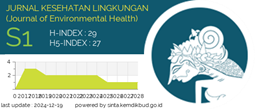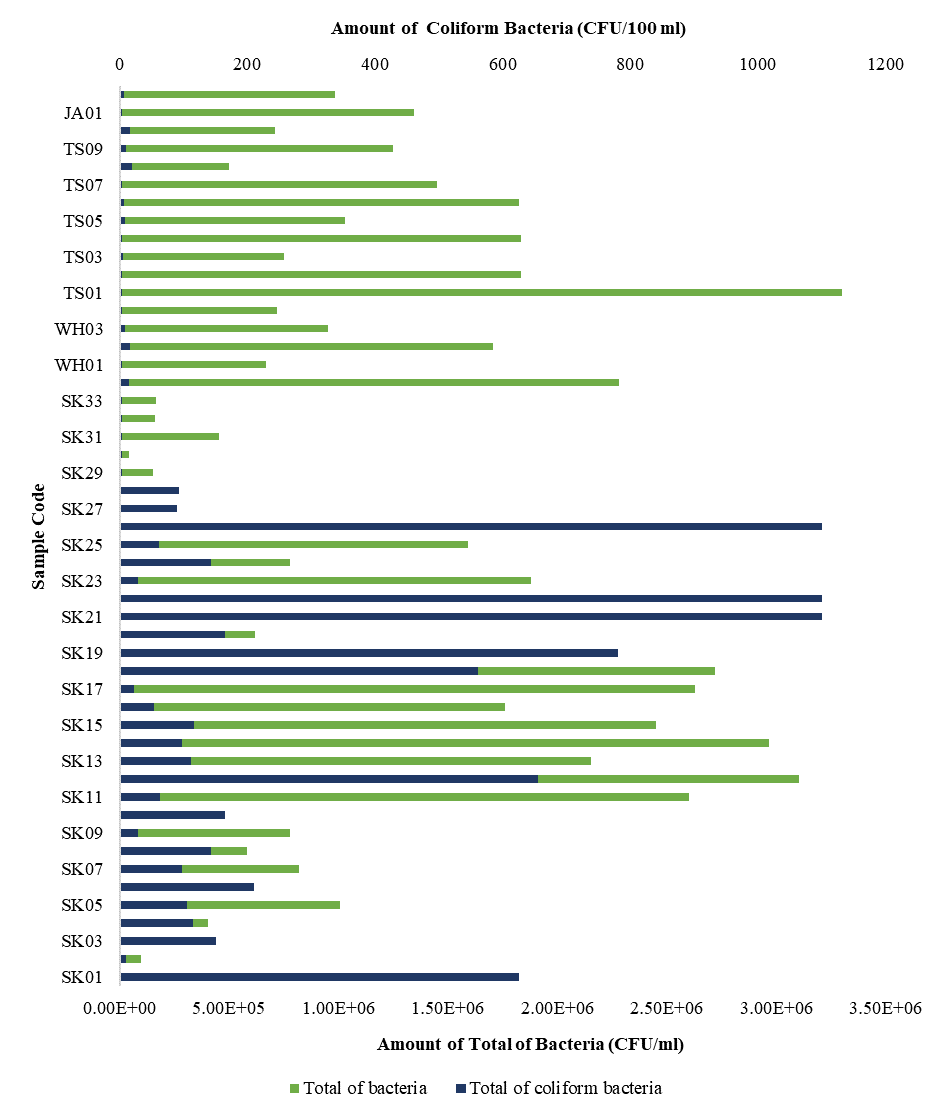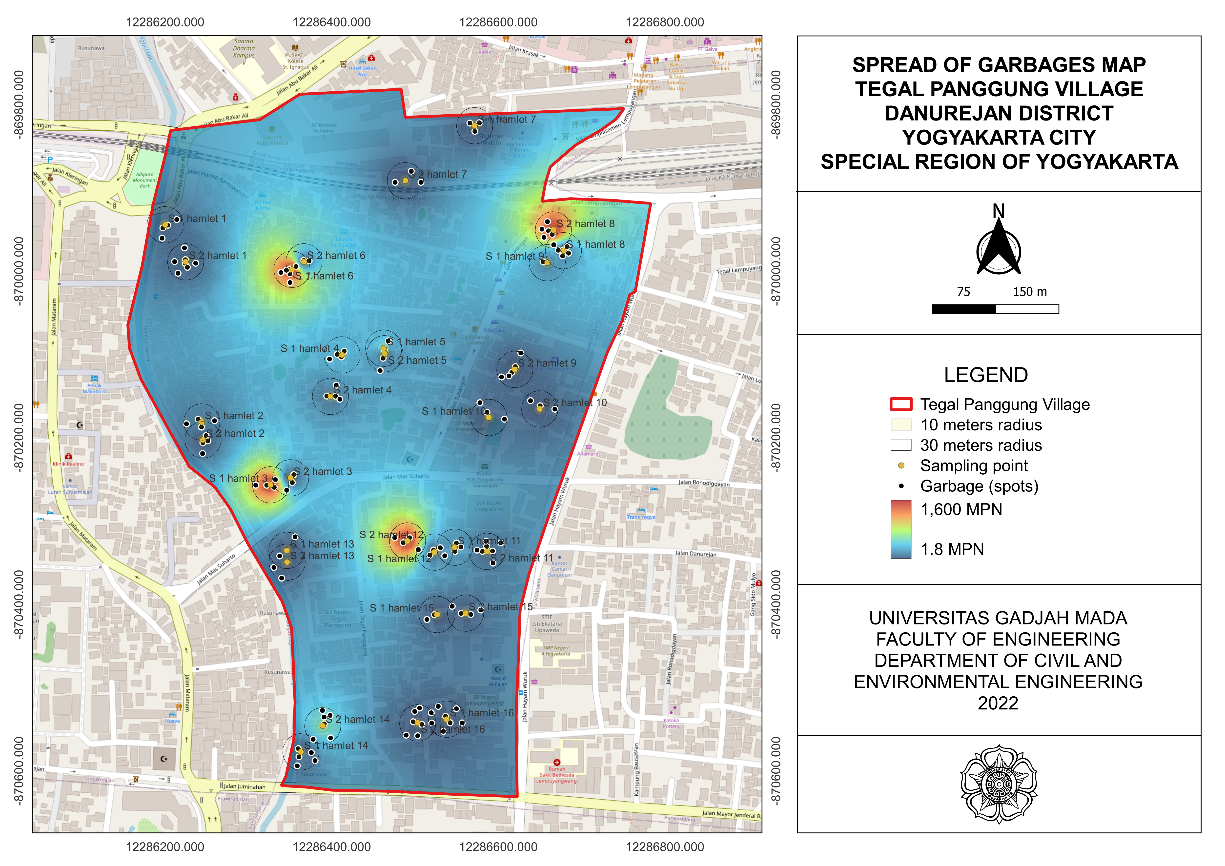Waste Management the Low-Cost Apartment Building, District of Baleendah Bandung 2018
Downloads
Introduction: Bandung was one of the areas that had not applied a good waste management yet. From 1,440 tons/day waste produced around 320 tons were managed. The effects of untreated waste were carrying the vector of disease, aesthetic decrease, environmental quality, and flood. The aim of this research was to identify the condition of waste management in Rusunawa Balaendah in 2018. Method: The research used observational method with cross sectional design. The object of this research was families who lived in Rusunawa Balaeendah with 60 respondents were obtained with sampling random area tehcnique. Observation variables were sorting, storing, collecting, and the amount of waste generation. This research used direct measurement method to calculated the waste generation during 8 days in May 15 to 21 2018 according to SNI No. 19-3964-1994. Method for collected the data used interview and field observation. The data was presented by table frequency distribution and chart to analyzed the result of the observation. Result and Discussion: The result of this research was shown that respondents who had good waste management were 3%, the storage phase for the ownership of trash that had not requirements yet were 70%, and garbage that was not in TPS was 97%. The amount of waste generation was 0.356kg/person/day. The level of respondents' knowledges about it was 45% which was on adequate category and the behaviour was 96,6% which was on deficient category. Conclusion: The result of this research was to know that waste management in Rusunawa Balaeendah was not appropriate with the provision. Based on the research, the suggestion is to build a garbage dump that has 3R method of waste management and to collaborate with DKRTH for the transfer of residual waste.
Amasuomo E, Baird J. The Concept of Waste and Waste Management. J of Management Sustainability. 2016;6(4):88-96. http://www.ccsenet.org/journal/index.php/jms/article/view/64728
Acvi DE. Waste Management in Ancient Times and Today from the Perspective of Teachers : Reflections to Diaries. Eu J Economics Business and Studies. 2015;1(April):8–13. http://journals.euser.org/index.php/ejes/article/view/427
Anindyajati R, Miftahul I. Peluang Penguatan Bank Sampah untuk Mengurangi Timbulan Sampah Perkotaan. Jurnal Teknologi Lingkungan. 2017;18(1):112–119. http://dx.doi.org/10.29122/jtl.v18i1.1743
Tampuyak S, Anwar C, Nur Sangadji M. Analisis Proyeksi Pertumbuhan Penduduk dan Kebutuhan Fasilitas Persampahan di Kota Palu 2015-2025. Jurnal Katalogis. 2016 Apr;4(4):94–104. http://jurnal.untad.ac.id/jurnal/index.php/Katalogis/article/view/6578
Kumala YS, Pawenang ET. Kondisi Sanitasi dan Kepadatan Lalat Kantin Sekolah Dasar Wilayah Kerja Puskesmas Kedungmundu. J of Health Edu. 2017;2(1):101–106. https://doi.org/10.15294/jhe.v2i1.19118
Mahyudin RP. Kajian Permasalahan Pengelolaan Sampah dan Dampak Lingkungan di TPA (Tempat Pemrosesan Akhir). Jukung Jurnal Teknik Lingkungan. 2017;3(1):66–74. https://ppjp.ulm.ac.id/journal/index.php/jukung/article/download/3201/2745
Anatolia L. Pengaruh Pengelolaan Sistem Pembuangan Akhir Sampah dan Dampak Terhadap Kesehatan Masyarakat di Desa Tibar, Kecamatan Bazartete, Kabupaten Liquiça, Timor-Leste. Bumi Lestari. 2015;15(2):115–124. https://ojs.unud.ac.id/index.php/blje/article/view/19011
Emilda NAP, Septiani RP. Dampak Pengelolaan Sampah Pada Kesehatan Masyarakat di TPA. Jurnal Ilmiah Ilmu Kesehatan Wawasan Kesehatan. 2019;5(2):246–252. http://journal.stikes-kapuasraya.ac.id/index.php/JIIK-WK/article/view/138
Indratik E, Yosefi D, Djaenudin, Aulia M. Penanganan Sampah Rumah Tangga di Kota Bandung : Nilai Tambah dan Potensi Ekonomi. Jurnal Penelitian Sosial dan Ekonomi Kehutanan. 2018;15(3):195–211. http://ejournal.forda-mof.org/ejournal-litbang/index.php/JPSEK/article/download/4633/pdf
Mustofa MU. Deradikalisasi Semu: Strategi Derutinisasi Penanganan Sampah Analisis Struktur dalam Isu Penanganan Sampah di Kota Bandung oleh Walikota Periode 2013-2018. Jurnal Wacana Politik. 2016;1(2):152–165. http://jurnal.unpad.ac.id/wacanapolitik/article/download/11057/pdf
Kusuma M. Tingkat Kepuasan Penghuni Rusunawa Terhadap Fisik dan Lingkungan Rusunawa di Surakarta. Ind J of Spatial and Regional Analysis. 2017;1-6. http://eprints.ums.ac.id/55961/
Pantur MF. Kajian Pengelolaan Persampahan di Rumah Susun (Studi Kasus: Rumah Susun Sarijadi, Kota Bandung). Skripsi. Bandung: Universitas Pasundan; 2017. http://repository.unpas.ac.id/30651/
Sugiyono. Metode Penelitian Kuantitatif Kualitatif Dan R&D. Bandung: Alfabeta; 2011.
Badan Standarisasi Nasional. SNI 19-3964-1994 tentang Metode Pengambilan dan Pengukuran Contoh Timbulan dan Komposisi Sampah Perkotaan. Jakarta: Pokja PPAS; 2019.
Arikunto S. Prosedur Penelitian: Suatu Pendekatan Praktik. Jakarta: Rineka Cipta; 2016.
Badan Standarisasi Nasional. SNI 3242:2008 tentang Pengelolaan Sampah di Permukiman. Jakarta: Badan Standarisasi Nasional; 2008.
Tachya RA, Sekarningrum B. Modal Sosial dalam Penanggulangan Bencana Banjir (Kasus di Kabupaten Bandung, Jawa Barat). Jurnal Pemikiran dan Penelitian Sosiologi. 2017;1(2):101–114. https://doi.org/10.24198/jsg.v1i2.13306
Ramon A, Afriyanto A. Karakteristik Penanganan Sampah Rumah Tangga di Kota Bengkulu. Jurnal Kesehatan Masyarakat Andalas. 2017;10(1):24-31. https://doi.org/10.24893/jkma.v10i1.159
Zamzami M, Nuril K, Tahirah T, Ahmad Y, Citra Y, Ragil D, et al. Analisis Pengelolaan Sampah Pada Masyarakat Desa Disanah Kecamatan Sreseh Kabupaten Sampang. Jurnal Kesehatan Lingkungan. 2018;10(4):368–375. https://e-journal.unair.ac.id/JKL/article/view/6424/5796
Sudiro, Setyawan A, Nulhakim L. Model Pengelolaan Sampah Permukiman di Kelurahan Tunjung Sekar Kota Malang. Jurnal Plano Madani. 2018;7(1):106–117.
https://doi.org/10.24252/planomadani.v7i1a10
Wahyudi J. Emisi Gas Rumah Kaca (GRK) dari Pembakaran Terbuka Sampah Rumah Tangga Menggunakan Model IPCC. Jurnal Litbang. 2019;15(1):65–76. https://doi.org/10.33658/jl.v15i1.132
Sofriadi D, Suhendrayatna, Fatimah E. Estimasi Emisi Karbon dari Sampah Permukiman dengan Metode IPCC di Kecamatan Ulee Kareng, Banda Aceh. Jurnal Teknik Sipil Univ Syiah Kuala. 2017;1(2):339–348. http://www.jurnal.unsyiah.ac.id/JTS/article/view/9944
Iswanto, Sudarmadji, Tri E, Heru A. Timbulan Sampah B3 Rumah Tangga dan Potensi Dampak Kesehatan Lingkungan di Kabupaten Sleman, Yogyakarta. Jurnal Manusia dan Lingkungan. 2016;23(2):179–188. https://doi.org/10.22146/jml.18789
Widodo S, Aruming N. Studi Timbulan dan Komposisi Sampah Rumah Tangga Kota Magelang. Jurnal Georafflesia. 2018;3(2):74–80. https://journals.unihaz.ac.id/index.php/georafflesia/article/view/588
Chandra, Akhmad F, Febriza M. Hubungan Antara Pengetahuan dan Sikap dengan Perilaku Hidup Bersih dan Sehat (PHBS) Pada Siswa Sekolah Dasar (SD) di Kecamatan Cerbon Tahun 2016. Jurnal Kesehatan Masyarakat Khatulistiwa. 2017;4(3):201–205. http://dx.doi.org/10.29406/jkmk.v4i3.849
2. Formal legal provisions to access digital articles of electronic journal are subject to the provision of the Creative Commons Attribution-ShareAlike license (CC BY-NC-SA), which means that Jurnal Kesehatan Lingkungan is rightful to keep, transfer media/format, manage in the form of databases, maintain, and publish articles.
3. Published manuscripts both printed and electronic are open access for educational, research, and library purposes. Additionally, the editorial board is not responsible for any violations of copyright law.
JKESLING by UNAIR is licensed under a Creative Commons Attribution-ShareAlike 4.0 International License.







































